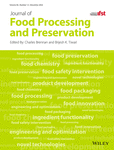Effects of hydroxyl radical oxidation on physicochemical properties and degradation of chicken myofibrillar protein
Yabo Wei and Ling Hu contributed equally to this study.
Abstract
The most significant issue influencing the preservation and sale of chicken is its oxidative behavior. The effect of hydroxyl radical oxidation on the hydrolysis of myofibrillar protein by μ-calpain in vitro was explored in this work, which looked at the alteration of chicken myofibrillar protein by hydroxyl radical oxidation. The carbonyl, dimerized tyrosine content and surface hydrophobicity of myofibrillar protein increased significantly as H2O2 concentration increased, tryptophan fluorescence intensity and total sulfhydryl content decreased. Compared with the control group, the carbonyl content of 10 mmol/L H2O2 treatment group increased to 1.7 nmol/mg protein, the surface hydrophobicity and the dimer tyrosine content increased 32.41% and 14.73%, respectively, the total sulfhydryl content decreased to 67.93 nmol/mg protein. The protein cross-linked and aggregated, and the oxidative modification of chicken myofibrillar protein promoted degradation. Desmin degradation by μ-calcinase is inhibited by MHC, actin, and troponin-T. The findings revealed that oxidation influenced the hydrolysis of myofibrillar protein and the tenderness of chicken after slaughter.
Novelty impact statement
- The chicken myofibrillar proteins were cross-linked and aggregated by hydroxyl radical oxidation.
- The oxidative modification of hydroxyl radical changes the sensitivity of protein to μ-calpain.
- The oxidative modification of chicken myofibrillar protein improved the tenderness of postmortem chicken by promoting the degradation of MHC, actin, and troponin-T caused by μ-calcium-activating enzyme.
CONFLICT OF INTEREST
The authors have declared no conflicts of interest for this article.
Open Research
DATA AVAILABILITY STATEMENT
The data that support the findings of this study are available from the corresponding author upon reasonable request.




